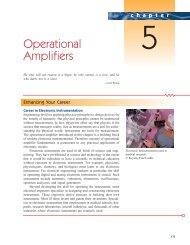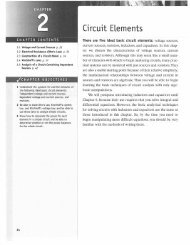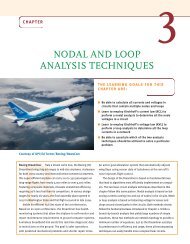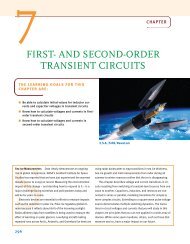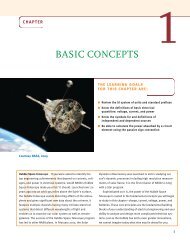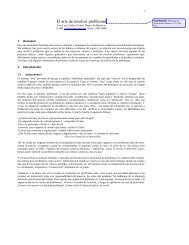Fundamentals of Electric Circuits
Fundamentals of Electric Circuits
Fundamentals of Electric Circuits
Create successful ePaper yourself
Turn your PDF publications into a flip-book with our unique Google optimized e-Paper software.
3.2 Nodal Analysis 83<br />
since it is assumed to have zero potential. A reference node is indicated<br />
by any <strong>of</strong> the three symbols in Fig. 3.1. The type <strong>of</strong> ground in Fig. 3.1(c)<br />
is called a chassis ground and is used in devices where the case, enclosure,<br />
or chassis acts as a reference point for all circuits. When the<br />
potential <strong>of</strong> the earth is used as reference, we use the earth ground in<br />
Fig. 3.1(a) or (b). We shall always use the symbol in Fig. 3.1(b).<br />
Once we have selected a reference node, we assign voltage designations<br />
to nonreference nodes. Consider, for example, the circuit in<br />
Fig. 3.2(a). Node 0 is the reference node (v 0), while nodes 1 and<br />
2 are assigned voltages v 1 and v 2 , respectively. Keep in mind that the<br />
node voltages are defined with respect to the reference node. As illustrated<br />
in Fig. 3.2(a), each node voltage is the voltage rise from the reference<br />
node to the corresponding nonreference node or simply the<br />
voltage <strong>of</strong> that node with respect to the reference node.<br />
As the second step, we apply KCL to each nonreference node in<br />
the circuit. To avoid putting too much information on the same circuit,<br />
the circuit in Fig. 3.2(a) is redrawn in Fig. 3.2(b), where we now add<br />
i 1 , i 2 , and i 3 as the currents through resistors R 1 , R 2 , and respectively.<br />
At node 1, applying KCL gives<br />
I 1 I 2 i 1 i 2<br />
R 3 ,<br />
(3.1)<br />
At node 2,<br />
I 2 i 2 i 3<br />
(3.2)<br />
We now apply Ohm’s law to express the unknown currents i 1 , i 2 , and<br />
i 3 in terms <strong>of</strong> node voltages. The key idea to bear in mind is that, since<br />
resistance is a passive element, by the passive sign convention, current<br />
must always flow from a higher potential to a lower potential.<br />
Current flows from a higher potential to a lower potential in a resistor.<br />
We can express this principle as<br />
i v higher v lower<br />
R<br />
(3.3)<br />
Note that this principle is in agreement with the way we defined resistance<br />
in Chapter 2 (see Fig. 2.1). With this in mind, we obtain from<br />
Fig. 3.2(b),<br />
i 1 v 1 0<br />
or i 1 G 1 v 1<br />
R 1<br />
i 2 v 1 v 2<br />
R 2<br />
or i 2 G 2 (v 1 v 2 )<br />
i 3 v 2 0<br />
R 3<br />
or i 3 G 3 v 2<br />
Substituting Eq. (3.4) in Eqs. (3.1) and (3.2) results, respectively, in<br />
(3.4)<br />
The number <strong>of</strong> nonreference nodes is<br />
equal to the number <strong>of</strong> independent<br />
equations that we will derive.<br />
(a) (b) (c)<br />
Figure 3.1<br />
Common symbols for indicating a<br />
reference node, (a) common ground,<br />
(b) ground, (c) chassis ground.<br />
i 2 i 2<br />
v 1<br />
I 1 R 1 R 3<br />
I 2<br />
1<br />
R 2 2<br />
I 1<br />
+<br />
v 1 R 1<br />
+<br />
v 2 R 3<br />
−<br />
−<br />
0<br />
(a)<br />
I 2<br />
R 2 v 2<br />
i 1<br />
i 3<br />
(b)<br />
Figure 3.2<br />
Typical circuit for nodal analysis.<br />
I 1 I 2 v 1<br />
v 1 v 2<br />
R 1 R 2<br />
I 2 v 1 v 2<br />
v 2<br />
R 2 R 3<br />
(3.5)<br />
(3.6)




